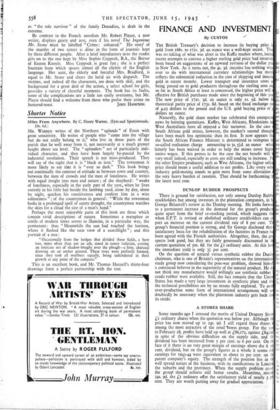FINANCE AND INVESTMENT
By CUSTOS
11 CC THE British Treasury's decision to increase its buying price gold from 168s. to 172s. 3d. an ounce was a well-kept secret. Th was no inkling of what was afoot in the Kaffir market where, ind recent attempts to canvass a higher sterling gold price had invariah been based on suggestions of an upward revision of the dollar pr. in New York. As it turns out, the 4$. 3d. increase has nothing wha ever to do with international currency relationships but mere reflects the substantial reduction in the cost of shipping and in.sun gold in recent months. Lower transport and insurance costs being passed on to gold producers throughout the sterling area a so far as South Africa at least is concerned, the higher price will effective for British purchases made since the beginning of this y The new price of 172s. 3d. an ounce is only is. 5d. below theoretical parity price of 173s. 8d. based on the fixed exchange ra of 4.03 dollars to the pound and the U.S. gold buying price of 3 dollars an ounce. THE British Treasury's decision to increase its buying price gold from 168s. to 172s. 3d. an ounce was a well-kept secret. Th was no inkling of what was afoot in the Kaffir market where, ind recent attempts to canvass a higher sterling gold price had invariah been based on suggestions of an upward revision of the dollar pr. in New York. As it turns out, the 4$. 3d. increase has nothing wha ever to do with international currency relationships but mere reflects the substantial reduction in the cost of shipping and in.sun gold in recent months. Lower transport and insurance costs being passed on to gold producers throughout the sterling area a so far as South Africa at least is concerned, the higher price will effective for British purchases made since the beginning of this y The new price of 172s. 3d. an ounce is only is. 5d. below theoretical parity price of 173s. 8d. based on the fixed exchange ra of 4.03 dollars to the pound and the U.S. gold buying price of 3 dollars an ounce.
Naturally, the gold share market has celebrated this unexpect news by hoisting quotations. Kaffirs, West Africans, Rhodesians a West Australians have all enjoyed a fait turnover. In the case South African gold mines, however, the market's second though have been much less optimistic than its first. It now appears th the South African Finance Minister is determined to reimpose 1 so-called realisation charge amounting to 3s. 51d. an ounce will Ul latterly has been waived in order to help the mines cover high 31 native wages. If this proves to be the case the net_ benefit will 2 very small indeed, especially as costs are still tending to increase. F the other Empire producers, such as West Africans, the higher sellt price should mean a useful addition to net profits. Like every oth industry gold-mining stands to gain most from some alleviation the very heavy burden of taxation. That should be forthcoming the latest next year. 9 DUNLOP RUBBER PROSPECTS 9 There is ground for satisfaction, not only among Dunlop Rub stockholders but among investors in the plantation companies, in S George Beharrell's review at the Dunlop meeting. He looks forw to a permanent increase in the demand for the group's produ ri quite apart from the brief re-stocking period, which suggests t when E.P.T. is revised or abolished ordinary stockholders can e pect an increase on the current dividend rate of 8 per cent. group's financial position is strong, and Sir George disclosed that satisfactory basis for the rehabilitation of the factories in France h been agreed with the French authorities. Altogether, then the p spects look good, but they are fairly generously discounted in current quotation of 50s. 6d. for the Li ordinary units. At this ler the immediate yield is only 3+ per cent. On the question of natural versus synthetic rubber the Duni chairman, who is one of Britain's representatives on the intematio study group now considering the post-war problem' showed hims a convinced believer in the superiority of the natural product. He d not think any manufacturer would willingly use synthetic rubber crude rubber were available. Still, the fact remains /hat the Unit States has made a very large investment in synthetic plant and th the technical possibilities are by no means fully explored. To av over-production some form of international arrangement will u doubtedly be necessary when the plantation industry gets back in its stride.
A STORES SHARE
Some months ago I stressed the merits of United Drapery .Stor Li ordinary shares when the quotation was below par. Although ill price has now moved up to 2.4s. 9d. I still regard these shares among the most attractive of the retail ttores group. For the ve- to February 28, profits have held up well at £86,272, against £84,09 in spite of the obvious difficulties on the supply side, and th dividend has been increased from 5 per cent. to 6 per cent. On face of it there is no very great margin of earnings above the 6 cent, dividend, but on the group's figures as a whole it seems th earnings for 1943-44 were equivalent to about ri per cent. on parent company's equity. The strength of the position lies in well spread nature of the business, with its ramifications in LOnd the suburbs and the provinces. When the supply problem cea the groutt should achieve still better results. Meantime, ,arou 24s. 9d. the £i ordinary offer the satisfactory yield of nearly 5 cent. They are worth putting away for gradual appreciation.


























 Previous page
Previous page